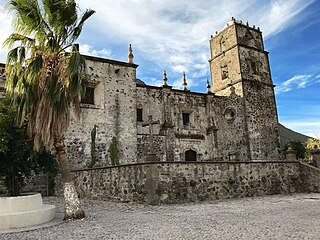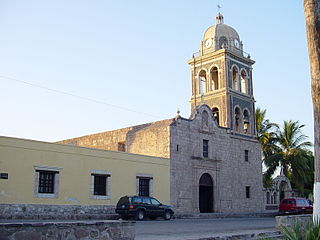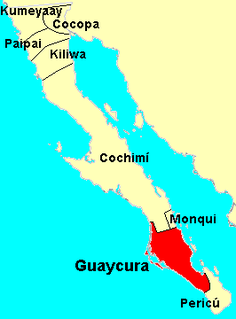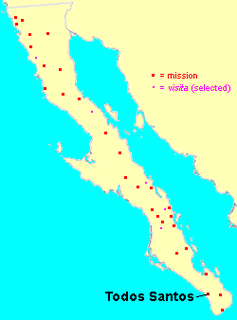
Misión San Francisco Javier de Viggé-Biaundó was a Spanish mission in San Javier, Baja California Sur, on the Baja California peninsula. It was built during the colonial era of the Viceroyalty of New Spain. The site is in present-day Loreto Municipality of Baja California Sur state. The mission was located at 25°51′38″N111°32′37″W. San Francisco Javier mission was founded by Jesuits of the Roman Catholic church in 1699 and closed in 1817.

Mission Santa Gertrudis, originally to be called Dolores del Norte, was a Spanish mission established by the Jesuit missionary Georg Retz in 1752 in what is today the Mexican state of Baja California. It is located about 80 km (50 mi) north of San Ignacio, Baja California Sur.

Mission Santa María de los Ángeles was the last of the missions established by the Jesuits in Baja California, Mexico, in 1767. The mission was named after Saint Maria of the Angels.

Misión de Nuestra Señora de Loreto Conchó, or Mission Loreto, was founded on October 25, 1697, at the Monqui Native American (Indian) settlement of Conchó in the city of Loreto, Baja California Sur, Mexico. Established by the Catholic Church's Jesuit missionary Juan María de Salvatierra, Loreto was the first successful mission and Spanish town in Baja California.

The Spanish missions in Baja California were a large number of religious outposts established by Catholic religious orders, the Jesuits, the Franciscans and the Dominicans, between 1683 and 1834 to spread the Christian doctrine among the Native Americans or Indians living on the Baja California peninsula. The missions gave Spain a valuable toehold in the frontier land, and introduced European livestock, fruits, vegetables, and industry into the region. The Indians were severely impacted by the introduction of European diseases such as smallpox and measles and by 1800 their numbers were a fraction of what they had been before the arrival of the Spanish.

The Guaycura were a native people of Baja California Sur, Mexico, occupying an area extending south from near Loreto to Todos Santos They contested the area around La Paz with the Pericú. The Guaycura were nomadic hunter-gatherers. They are distinguished by a language unrelated to any other Native American language, indicating in the opinion of some linguists that their ancestry in Baja California dates back thousands of years.
Mission San Bruno was a short-lived Spanish mission established by Jesuit order on October 7, 1684 in what is now the Loreto Municipality of Baja California Sur, Mexico. The mission was the first Spanish mission established on the Baja California Peninsula.

Johann Jakob Baegert was a Jesuit missionary at San Luis Gonzaga in Baja California Sur, Mexico. He is noted for his detailed and acerbic account of the peninsula, the culture of its native inhabitants, and the history of its Spanish exploration and missionization.

Mission San José de Comondú was one of the Jesuit missions established early in the 18th century in Baja California Sur, Mexico, west of Loreto on an arroyo flowing to the Pacific coast. Over the course of its existence, the mission was twice relocated.
Francisco María Piccolo, S.J., (1654–1729) was one of the first Jesuit missionaries in Baja California Sur, New Spain, now Mexico. His letters and reports are important sources for the ethnography and early history of the peninsula.

Mission La Purísima, was founded west of Loreto in Baja California Sur, by the Jesuit missionary Nicolás Tamaral in 1720 and financed by the Marqués de Villapuente de la Peña and his wife the Marquesa de las Torres de Rada.

Mission La Paz was established by the Jesuit missionaries Juan de Ugarte and Jaime Bravo in 1720 and financed by the Marqués de Villapuente de la Peña, at the location of the modern city of La Paz, Baja California Sur, Mexico.

Mission Guadalupe was established by the Jesuit Everardo Helen in 1720, at the Cochimí settlement of Huasinapí in the Sierra de la Giganta about 40 kilometers west of Mulegé, Baja California Sur, Mexico. The mission was named after Our Lady of Guadalupe.

The Jesuit missionary Clemente Guillén founded Mission Dolores in 1721 and sponsored by the Marqués de Villapuente de la Peña, on the Gulf coast of Baja California Sur, Mexico, about midway between Loreto and La Paz in Baja California Sur, Mexico. The mission was dedicated to Our Lady of Sorrows.

Mission Santiago was founded by the Italian Jesuit Ignacio María Nápoli in 1724 and financed by the Marqués de Villapuente de la Peña and his wife the Marquesa de las Torres de Rada, at the native settlement of Aiñiní, about 40 kilometers north of San José del Cabo in the Cape Region of Baja California Sur, Mexico.
The Visita de San Juan Bautista Londó was a Catholic visita located at the Cochimí settlement of Londó in what is now Loreto Municipality, Baja California Sur, Mexico. The visita was founded by Jesuit missionaries Juan María Salvatierra and Francisco María Piccolo in 1699 as an extension of Misión de Nuestra Señora de Loreto Conchó.

Misión Santa Rosa de las Palmas, also known as Todos Santos Mission, was founded by the Roman Catholic Jesuits in 1733 and dedicated to Saint Rose of Lima. After 1748, the mission was known as Nuestra Señora del Pilar de la Paz. The mission was the first European settlement at the site of what is now the city of Todos Santos, Baja California Sur.

Mission San Ignacio Kadakaaman was founded by the Jesuit missionary Juan Bautista de Luyando in 1728 at the site of the modern town of San Ignacio, Baja California Sur, Mexico.

Waikuri is an extinct language of southern Baja California spoken by the Waikuri or Guaycura people. The Jesuit priest Baegert documented words, sentences and texts in the language between 1751 and 1768.

Lorenzo José Carranco was a Jesuit missionary.

















